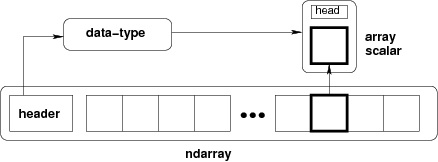|
||||||||||||||
|
Ndarray Object
Время создания: 29.09.2017 21:28
Раздел: numPy
Запись: xintrea/mytetra_db_mcold/master/base/15067097128bhb0219i1/text.html на raw.githubusercontent.com
|
||||||||||||||
|
|
||||||||||||||
|
The most important object defined in NumPy is an N-dimensional array type called ndarray. It describes the collection of items of the same type. Items in the collection can be accessed using a zero-based index. Every item in an ndarray takes the same size of block in the memory. Each element in ndarray is an object of data-type object (called dtype). Any item extracted from ndarray object (by slicing) is represented by a Python object of one of array scalar types. The following diagram shows a relationship between ndarray, data type object (dtype) and array scalar type − An instance of ndarray class can be constructed by different array creation routines described later in the tutorial. The basic ndarray is created using an array function in NumPy as follows − numpy.array It creates an ndarray from any object exposing array interface, or from any method that returns an array. numpy.array(object, dtype = None, copy = True, order = None, subok = False, ndmin = 0) The above constructor takes the following parameters −
Take a look at the following examples to understand better. Example 1 import numpy as np a = np.array([1,2,3]) print a The output is as follows − [1, 2, 3] Example 2 # more than one dimensions import numpy as np a = np.array([[1, 2], [3, 4]]) print a The output is as follows − [[1, 2] [3, 4]] Example 3 # minimum dimensions import numpy as np a = np.array([1, 2, 3,4,5], ndmin = 2) print a The output is as follows − [[1, 2, 3, 4, 5]] Example 4 # dtype parameter import numpy as np a = np.array([1, 2, 3], dtype = complex) print a The output is as follows − [ 1.+0.j, 2.+0.j, 3.+0.j] The ndarray object consists of contiguous one-dimensional segment of computer memory, combined with an indexing scheme that maps each item to a location in the memory block. The memory block holds the elements in a row-major order (C style) or a column-major order (FORTRAN or MatLab style). |
||||||||||||||
|
Так же в этом разделе:
|
||||||||||||||

|
||||||||||||||
|
||||||||||||||
|




